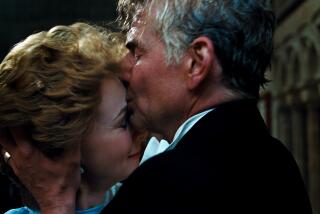Review: Camerata Pacifica introduces John Harbison’s curvy string trio
Tuesday night, entering the Pasadena Civic Auditorium, it was out of the oven — the temperature still in the upper 90s at 8 p.m. — and into John Harbison’s frying pan for the premiere of his String Trio, commissioned by Camerata Pacifica to open the Santa Barbara-based chamber music ensemble’s 25th season.
“Let the critic not be fooled,” the 75-year-old composer writes in his program note of a new score, “by this veneer of friendliness. I have a knife for his ribs later on, at the moment of greatest security.”
It was too hot to wear protective clothing, but this critic came prepared, nonetheless. Although technically a premiere in the Camerata’s peripatetic series (each program is given in Montecito, Ventura, Los Angeles and, finally, the Pasadena Civic’s intimate Gold Room), Harbison’s trio was recorded earlier this year by the Camerata. The vivid-sounding Harmonia Mundi release came out last week.
Harbison is not the first to pull out a knife in a string trio. In the land of chamber music, violin, viola and cello are barely company, let alone a crowd. The string quartet has always been the four-part harmony ideal. The string trio, with its thinner texture leaving fewer sonic corners in which to hide, is the far more vulnerable chamber music vehicle.
Consequently, there have been but a handful of notable string trios other than Mozart’s Divertimento in E flat, his largest chamber work and the model for Harbison’s trio. Schoenberg’s late Trio is a startling musical description of heart attack and hospital stay, with a surgeon’s knife at the ready. Karlheinz Stockhausen named his 2007 string trio “Hope” and then died suddenly not long afterward. Webern’s String Trio, his first 12-tone score, was a way to cut through tonal harmony. La Monte Young’s 1957 String Trio took the blade to the 12-tone technique for what became a prescient prelude to Minimalism.
Harbison’s inspiration was back to Mozart. He mirrors the six-movement structure of the Divertimento. The new trio begins each movement with a harmonically skewered version of Mozart’s melodic gambits. But Harbison’s path is ultimately closer to Schoenberg’s. The motives seem to have a life of their own, moving into surreal terrains.
Were Harbison to name his 30-minute trio, it might be “Red Herring.” He throws curves, not that that is the right metaphor. Melodic shapes may be Mozartean, but the pitch material for melodic motives comes from the letters of Lionel Messi’s name, for the simple reason, Harbison writes, that the Argentine is the Mozart of soccer.
Even the knife in the ribs is an intriguing red herring. The viola part is written for an exciting and sassy player, Richard Yongjaei O’Neill, and it gets wildly unhinged at the end. But Harbison precedes that with an extraordinary series of theatrical relationships between three exceptional players — the others being violinist Movses Pogossian and cellist Ani Aznavoorian.
By the end, violence is no longer out of the question. This is a major addition to the tiny string trio repertory.
The program began with Mozart’s early First Flute Quartet and ended with Schubert’s powerful, irrepressibly tuneful Second Piano Trio. Adrian Spence was the flutist in the pleasant Mozartean palate cleanser. Pogossian was the vigorous evening’s violinist. Raman Ramakrishnan was mellow cellist in the Mozart and Schubert.
Pianist Warren Jones joined in for the Schubert, and here three became a crowd. Ramakrishnan’s tone is small; he is a lyrical, not dramatic player. Pogossian is a sophisticated virtuoso, subtle and bold in his phrasing. But Jones dominated in volume of sound and by relentlessly pushing forward. Schubert’s trio normally advances at a leisurely pace for 45 enthralling minutes. But at the moment of greatest security in this performance, the piano cut through the strings like a knife in poor Schubert’s ribs.
Twitter: @markswed
More to Read
The biggest entertainment stories
Get our big stories about Hollywood, film, television, music, arts, culture and more right in your inbox as soon as they publish.
You may occasionally receive promotional content from the Los Angeles Times.







